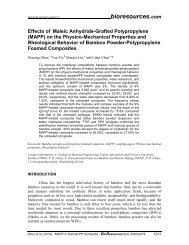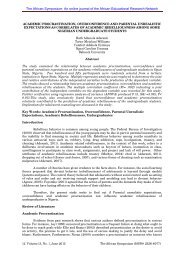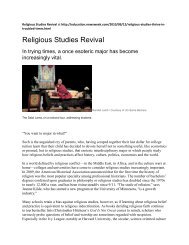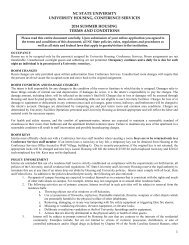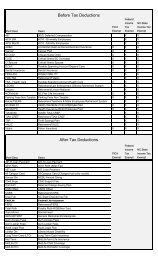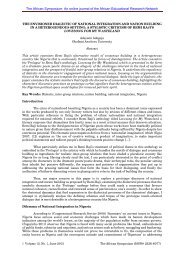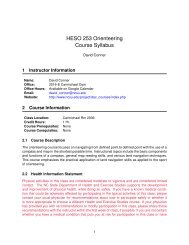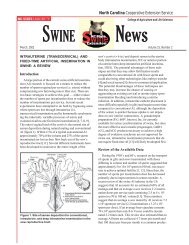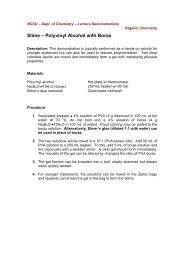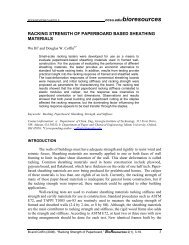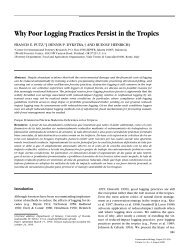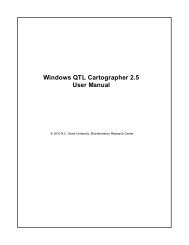MAGNETISM — A Few Basics
MAGNETISM — A Few Basics
MAGNETISM — A Few Basics
Create successful ePaper yourself
Turn your PDF publications into a flip-book with our unique Google optimized e-Paper software.
<strong>MAGNETISM</strong> <strong>—</strong> A <strong>Few</strong> <strong>Basics</strong><br />
1<br />
A. HISTORY<br />
Magnetite or lodestone (Fe II OFe III 2O 3 )<br />
mineral in its natural state often has a strong attraction for iron and steel...mined in magnesia<br />
but Pliny says it was named for the discoverer, a shepherd, magnes, "the nails of whose shoes<br />
and the tip of whose staff stuck fast in a magnetick field while he pastured his flocks."<br />
Lodestone appears in Greek writings by 800 B.C.<br />
First magnetic technological invention <strong>—</strong> compass: in China, sometime between 2637 B.C. and<br />
1100 A.D. (!)<br />
others say it was introduced to China in 1200s by Italians or Arabs<br />
Early theories and experiments on magnetism were developed by the great minds of all times <strong>—</strong><br />
Gilbert, Descartes, Coulomb, Poisson, Green, Oertsted, Ampere, Davy, Freesnel, Faraday,<br />
Maxwell...<br />
But: Quantum Mechanics is necessary to develop a viable model, and the model continues to<br />
evolve: <strong>MAGNETISM</strong> IS NOT A SOLVED PROBLEM<br />
B. BASICS<br />
All materials respond to an external magnetic field (H). The magnetization (M) of a sample is<br />
proportional to H:<br />
M = χH. The proportionality constant, χ, is the magnetic susceptibility<br />
C. TYPES OF <strong>MAGNETISM</strong> - see chart<br />
The Big five<br />
1. Diamagnetism<br />
electrons in closed shells cause a material to be repelled by H (χ < 0).<br />
Typically, χ m = -1x10 -6 emu/mol<br />
usually a very small contribution to χ exp<br />
χ exp = χ dia + χ para + χ Pauli<br />
χ dia <strong>—</strong> diamagnetic term due to closed-shell (core) electrons. ALL materials have this. For our<br />
systems, which will probably have a very small χ, the diamagnetic correction is non-trivial <strong>—</strong><br />
can be obtained from atom/group additivities or the Curie plot (see below).<br />
χ dia is temperature and field independent.<br />
χ para is due to unpaired electrons (= χ p )<br />
χ Pauli is typically seen in metals and other conductors - due to mixing excited states that are not<br />
thermally populated into the ground (singlet) state - temperature independent. Presumably not<br />
important in our systems.<br />
ALL OTHER TYPES OF <strong>MAGNETISM</strong> REQUIRE UNPAIRED SPINS (MOMENTS) <strong>—</strong> THE<br />
INTERACTIONS AMONG SPINS DETERMINES THE TYPE OF <strong>MAGNETISM</strong><br />
2. Paramagnetism<br />
randomly oriented, rapidly reorienting moments; no permanent, spontaneous magnetic moment<br />
(M = 0 if H = 0)<br />
spins are non-interacting (non-cooperative)<br />
all other forms of magnetism have a critical temperature, T C , below which there is some<br />
interaction of moments. Above T C ⇒ paramagnet<br />
χ p varies with T empirically according to the Curie Law:<br />
χ p<br />
= C T<br />
or the Curie-Weiss Law:<br />
C = Curie constant
χ p<br />
=<br />
C<br />
θ = Weiss constant<br />
T −θ<br />
θ is indicative of intermolecular interactions among the moments<br />
θ > 0 - ferromagnetic interactions (NOT ferromagnetism)<br />
θ < 0 - antiferromagnetic interactions (NOT antiferromagnetism)<br />
2<br />
DIA<strong>MAGNETISM</strong><br />
INCIPIENT<br />
FERRO<strong>MAGNETISM</strong><br />
META<strong>MAGNETISM</strong><br />
ANTI-<br />
FERRO<strong>MAGNETISM</strong><br />
FERRO<strong>MAGNETISM</strong><br />
FERRI<strong>MAGNETISM</strong><br />
SPERI<strong>MAGNETISM</strong><br />
SUPER-<br />
PARA<strong>MAGNETISM</strong><br />
PARA<strong>MAGNETISM</strong><br />
SPERO<strong>MAGNETISM</strong><br />
ASPERO<strong>MAGNETISM</strong><br />
SPIN GLASS<br />
HELI<strong>MAGNETISM</strong><br />
MICTO<strong>MAGNETISM</strong><br />
Using the Curie Plot:<br />
χ exp<br />
=<br />
C<br />
T −θ + χ T<br />
χ exp<br />
= C T +χ T<br />
(χ T = χ dia + χ Pauli = temperature independent contribution)<br />
(at high temperature if θ is small)
Plot χ exp vs 1/T<br />
0.4<br />
0.35<br />
para<br />
3<br />
0.3<br />
0.25<br />
0.2<br />
0.15<br />
0.1<br />
0.05<br />
Paramagnetic Susceptibility<br />
ferro<br />
antiferro<br />
slope = C; intercept = χ T; ⇒ χ exp - χ T = χ p<br />
...then plot 1/χ p vs. T<br />
0<br />
0 0.1 0.2 0.3 0.4 0.5<br />
1/Temperature (1/K)<br />
50<br />
θ = 0<br />
40<br />
30<br />
20<br />
10<br />
Paramagnetic Susceptibility<br />
θ = +2<br />
θ = -2<br />
slope = 1/C; intercept = θ/C<br />
0<br />
0 5 10 15 20<br />
1/Temperature (1/K)<br />
A magnetometer measures M which gives χ. Do the first plot to get χ T . Then at all T and H, χ p<br />
= χ exp - χ T<br />
The magnetization plot<br />
For an atom with spin m s , its energy in H is:<br />
E(m s<br />
) = m s<br />
gµ B<br />
H µ = -m s gµ B
µ B is Bohr magneton (= 9.27x10 -24 J/T); g is the Lande constant (= 2.0023192778)<br />
Consider N particles, with n i in ith level<br />
∑ n<br />
i i<br />
= N<br />
4<br />
⎛<br />
P i<br />
= n exp − ε i ⎞<br />
⎜ ⎟<br />
kT<br />
i<br />
N = ⎝ ⎠<br />
⎛<br />
exp − ε i ⎞<br />
∑ ⎜ ⎟<br />
i ⎝ kT ⎠<br />
M = N ∑ µ<br />
i i<br />
P i<br />
now, consider two spin states (m s = ± 1/2),<br />
+1/2<br />
⎛<br />
( −m s<br />
gµ B )exp −m s gµ B H ⎞<br />
∑<br />
⎜ ⎟<br />
ms=−1/2<br />
⎝ kT ⎠<br />
M = N<br />
+1/2 ⎛<br />
exp −m s gµ B H ⎞<br />
∑ ⎜ ⎟<br />
ms=−1/2 ⎝ kT ⎠<br />
= Ngµ B<br />
2<br />
= Ngµ B<br />
2<br />
⎡ ⎛<br />
exp gµ B H ⎞ ⎛<br />
⎜ ⎟ − exp − gµ B H ⎞ ⎤<br />
⎜<br />
⎢<br />
⎟<br />
⎝ 2kT ⎠ ⎝ 2kT ⎠<br />
⎥<br />
⎢<br />
⎛<br />
exp⎜<br />
gµ B H ⎞ ⎛<br />
⎟ + exp⎜<br />
− gµ B H ⎥<br />
⎢<br />
⎞<br />
⎟ ⎥<br />
⎣<br />
⎢ ⎝ 2kT ⎠ ⎝ 2kT ⎠ ⎦<br />
⎥<br />
⎛<br />
tanh gµ B H ⎞<br />
⎜ ⎟ since tanh(y) = (e y -e -y )/(e y +e -y )<br />
⎝ 2kT ⎠<br />
if y
a) For x >> 1, B S<br />
x<br />
⎡<br />
( ) − 1 2<br />
( ) = 1 S S+ 1 ⎣ 2<br />
⎤<br />
⎦ = 1<br />
x = gµ B H<br />
kT >> 1 means H T >> k<br />
= 1.38x10−23 J / K<br />
gµ B 2x9.27x10 −24 J/ T = 0.7T / K<br />
b) For x
S=1/2<br />
S=1<br />
S=3/2<br />
S=2<br />
S=5/2<br />
S=3<br />
S=7/2<br />
S=4<br />
S=9/2<br />
S=5<br />
M<br />
molar<br />
( µ B<br />
)<br />
10<br />
9<br />
8<br />
7<br />
6<br />
5<br />
4<br />
6<br />
3<br />
2<br />
1<br />
0<br />
0 1 2 3 4 5 6 7<br />
H/T (Tesla/Kelvin)<br />
The effective magnetic moment<br />
directly relates to number of spins:<br />
µ eff = g[S(S+1)] 1/2 µ B<br />
S µ eff / µ B<br />
1/2 1.73<br />
1 2.83<br />
2 4.89<br />
related to molar susceptibility (χ m = emu/mol)<br />
χ m<br />
= Nµ 2<br />
eff<br />
3kT<br />
= C'<br />
T<br />
µ eff<br />
= 3kC' = 2.82 C'<br />
Therefore,<br />
N<br />
µ eff<br />
= 2.824 χ m<br />
T<br />
3. Ferromagnetism<br />
moments throughout a material in 3-D tend to align parallel<br />
can lead to a spontaneous permanent M (in absence of H)<br />
but, in a macroscopic system, it is energetically favorable for spins to segregate into regions<br />
called DOMAINS - domains need not be aligned with each other<br />
A Domain<br />
may or may not have spontaneous M<br />
application of H causes aligned domains to grow at the expense of misaligned<br />
domains...alignment persists when H is removed
7<br />
Ferromagnetism is a critical phenomenon, involving a phase transition that occurs at a critical<br />
temperature, T c = Curie Temperature. Above T c ⇒ paramagnet<br />
T C is directly proportional to S(S+1)<br />
It takes energy to move domain walls - hysteresis:<br />
M = χH app<br />
Sample Magnetization<br />
M(+)<br />
M sat<br />
H app<br />
(-) (+)<br />
H app<br />
Applied Field M R<br />
2H C<br />
M(-)<br />
M R<br />
= Remnant Magnetization (M at H app<br />
= 0)<br />
M sat<br />
= Saturation Magnetization (M sat<br />
= Ngµ B<br />
S)<br />
H C<br />
= Coercive Field (H app<br />
required to flip M)<br />
"Hard" magnetic material = high Coercivity<br />
"Soft" magnetic material = low Coercivity<br />
Remanence: Magnetization of sample after H is removed<br />
Coercive field: Field required to flip M (+M to -M)<br />
4. Antiferromagnetism<br />
spins tend to align antiparallel in 3-D<br />
no spontaneous M<br />
no permanent M<br />
critical temperature: T N (Neel Temperature)<br />
above T N ⇒ paramagnet<br />
5. Ferrimagnetism<br />
requires two chemically distinct species with different moments<br />
they couple antiferomagnetically:<br />
no M; critical T = T C (Curie Temperature)<br />
bulk behavior very similar to ferromagnetism<br />
Magnetite is a ferrimagnet<br />
6. Other types<br />
M sat = Νgµ B S<br />
Electromagnets<br />
• High M R and Low H C<br />
Electromagnetic Relays<br />
• High M sat , Low M R , and Low H C<br />
Magnetic Recording Materials<br />
• High M R<br />
and relatively High H C<br />
Permanent Magnets<br />
• High M R<br />
and High H C
DIA<strong>MAGNETISM</strong><br />
INCIPIENT<br />
FERRO<strong>MAGNETISM</strong><br />
Low T; temporary alignment of moments<br />
of ions & itinerant electrons<br />
8<br />
META<strong>MAGNETISM</strong><br />
Field-induced transition to magnetic<br />
state;<br />
must be below Neel temperature<br />
ANTI-<br />
FERRO<strong>MAGNETISM</strong><br />
FERRO<strong>MAGNETISM</strong><br />
FERRI<strong>MAGNETISM</strong><br />
SPERI<strong>MAGNETISM</strong><br />
Two species frozen as in speromagnet;<br />
often net magnetication<br />
SUPER-<br />
PARA<strong>MAGNETISM</strong><br />
Small particle size allows single<br />
domain fluctuation; destroyed by<br />
cooling below blocking temperature<br />
PARA<strong>MAGNETISM</strong><br />
SPERO<strong>MAGNETISM</strong><br />
Local moments licked into random<br />
orientation;no net magnetiztion<br />
ASPERO<strong>MAGNETISM</strong><br />
As in speromagnetism, but some orientation;<br />
net magnetization<br />
SPIN GLASS<br />
Magnetic ions cooled in a nonmagnetic host;<br />
usually dilute; RKKY coupling only (?)<br />
HELI<strong>MAGNETISM</strong><br />
Crystalline asperomagnet<br />
MICTO<strong>MAGNETISM</strong><br />
Cluster glass; local correlations dominant<br />
D. SPECIAL TOPICS<br />
1. Magnetooptical Disks<br />
a. Reading<br />
Magnetic materials rotate plane polarized light<br />
in transmission: Faraday effect<br />
in reflection: Kerr effect (used in devices)<br />
Direction of rotation depends on polarization of M<br />
b. Writing<br />
actually a thermo-magnetic process since a high-powered laser is used to heat the sample<br />
1) Curie point writing-heat above T C , then cool in applied field<br />
2) Threshold (or compensation point) writing - if material has a temperature dependent<br />
coercive field heat to point where H > H c , then on cooling H < H c<br />
c. Materials<br />
Typically rare-earth transition metal alloys (RE-TM) RE: Gd, Tb; TM: Fe, Co
9<br />
Many factors to tune: T c , H c , Magnetic anisotropy, reflectivity, Kerr rotation, stability, etc.<br />
2. Spin Glasses <strong>—</strong> one of the more intriguing new forms of magnetism<br />
may be a new state of matter, maybe not<br />
prototypical SG is an alloy, with 1-10% of a paramagnetic impurity (e.g., Fe or Mn) in a<br />
diamagnetic metal (e.g. Cu or Au)<br />
Spin coupling is mediated through the conduction electrons through the RKKY interaction<br />
(Ruderman, Kittel, Kasuya, Yosida) - oscillatory in nature<br />
A<br />
B<br />
This leads to frustration:<br />
• •<br />
• •<br />
unfrustrated<br />
• ≡ ≡<br />
• •<br />
frustrated<br />
ferromagnetic coupling<br />
antiferromagnetic coupling<br />
• spin center<br />
C<br />
• • • •<br />
• • • •<br />
unfrustrated<br />
frustrated<br />
A critical consequence of Frustration is a highly degenerate ground state - there are<br />
MANY equally probable, equally acceptable combinations of spins<br />
Therefore, even at 0 Kelvin, many states are populated - novel thermodynamic and<br />
magnetic properties<br />
Experimentally, the hallmark of a SG is a cusp in the AC susceptibility - defines a critical<br />
temperature - T SG<br />
Heat capacity measurements do not reveal the some critical temperature<br />
SG do show remanence and hysteresis effects<br />
SG theory has been adopted to other problems, including:<br />
combinatorial optimization (traveling salesman) problems<br />
neural networks<br />
pre-biotic evolution<br />
E. MISCELLANY<br />
1. Units and fundamental constants<br />
N = 6.022 x 10 23 mol -1<br />
g = 2.0023<br />
k = 1.3807 x 10 -23 J/K<br />
µ B = 9.274 x 10 -24 J/T<br />
Nµ B 2 /k = 0.375 emu K/mol<br />
gµ B /k = 1.3449 K/T<br />
G = g 1/2 cm -1/2 s -1<br />
T = 10 4 G<br />
T 2 = 10 J/emu<br />
2. Saturation behavior of S-only paramagnets<br />
M = M sat B S (gµ B H/kT)<br />
B S (x) = (1/S)((S + 1/2)x coth(S + 1/2)x - (x/2) coth(x/2))
M sat = Ngµ B S = 11.18245 S J/mol•T = 1.118245 x 10 4 S emu•G/mol<br />
3. Curie Law for paramagnets<br />
M = χH<br />
χT = C = Ng 2 µ 2 B<br />
S(S +1)<br />
= 0.125g<br />
3k<br />
2 S(S+1) emu•K/mol<br />
µ eff = (g 2 S(S+1) 1/2 = (8χT) 1/2<br />
4. Relation between saturation and Curie behaviors<br />
C( emu •K)<br />
M sat<br />
( emu •G) = Ng 2 µ 2 B<br />
S(S +1)<br />
= gµ (S +1)<br />
B<br />
=<br />
3kNgµ B<br />
S<br />
3k<br />
10<br />
2.0023•9.274x10 −28 J/ G<br />
3•1.3807x10 −23 J / K (S +1) = 4.4831x10 −5 K (S +1)<br />
G<br />
F. MAGNETIC DIMERS – THE HEISENBERG-DIRAC-VAN VLECK HAMILTONIAN<br />
1. Introduction<br />
In section C.2 we examined primary magnetochemistry relationships for paramagnets –<br />
species with non-interacting spins. The magnetic properties of such materials can be described<br />
by the Curie-Weiss law (for small values of H/T), or more generally by:<br />
M = Ngµ B<br />
SB S<br />
However, in the next simplest case – a molecule with two exchange-coupled unpaired<br />
electrons – the magnetic properties cannot usually be described by this relation except at very<br />
low temperatures. This will be the case when the exchange coupling creates thermally accessible<br />
states of different spin multiplicity. Such is the case for most organic biradicals.<br />
The Heisenberg-Dirac-Van Vleck (HDVV) Hamiltonian, eq 1, is an empirical operator that<br />
models interaction (coupling) of unpaired electrons. The form of the Hamiltonian suggests that<br />
coupling arises through interaction of spin angular momentum operators. The magnitude of the<br />
interaction depends on the interaction parameter, J ij (called the exchange parameter). The J ij<br />
term embodies all of the interactions that determine the ground state spin preference. The<br />
product of spin operators is a reasonable component since interaction of species containing<br />
unpaired electrons results in either a decrease (antiferromagnetic coupling) or increase<br />
(ferromagnetic coupling) in spin angular momentum. For example, two doublets can couple to<br />
yield a singlet and a triplet, the relative energies of which depend on J ij . By definition, for<br />
ferromagnetic (high-spin) coupling J ij > 0, while for antiferromagnetic coupling, J ij < 0.<br />
H ˆ ij<br />
= −2J ˆ ij<br />
S ˆ i<br />
S j<br />
(1)<br />
The product of spin angular momentum operators may be expressed in terms of component<br />
and product (total) spin angular momentum operators,<br />
S ˆ 2<br />
Tot<br />
=<br />
⎛<br />
⎝<br />
S ˆ i<br />
+ S ˆ j<br />
therefore, ˆ S i ˆ<br />
2<br />
⎞<br />
⎠ = S ˆ i<br />
+ S ˆ j<br />
+ 2S ˆ ˆ i<br />
S j<br />
(2)<br />
S j<br />
= 1 ⎛<br />
S<br />
2 ˆ 2<br />
Tot<br />
− S ˆ i<br />
−S ˆ 2 ⎞<br />
⎝<br />
j ⎠<br />
(3)<br />
Since the eigenvalue of S ˆ 2 is S( S +1), the energy of the state with spin S Tot<br />
resulting from<br />
interaction of species with spins S i<br />
and S j<br />
is given by,
[ ( ) −S i ( S i<br />
+1) − S j ( S j<br />
+1)<br />
] (4)<br />
E Tot<br />
= −J ij<br />
S Tot<br />
S Tot<br />
+1<br />
Thus for two doublets (2 x multiplicity 2 = 4 states), coupling results in a triplet and a singlet<br />
(multiplicity 3 and multiplicity 1 = 4 states). In the case of ferromagnetic coupling (J > 0), the<br />
energy of the triplet state (S = 1) is,<br />
[ ] = − J 2<br />
E T<br />
= −J 11 ( +1) − 1 1<br />
2( 2 +1 )− 1 1<br />
[ 2( 2 +1 )] = −J 2 − 3 4 − 3 4<br />
The energy of the singlet state (S = 0) is,<br />
[ ] = 3J 2<br />
E S<br />
= −J 0( 0 +1) − 1 1<br />
2<br />
(<br />
2 +1 ) − 1 1<br />
[ 2<br />
(<br />
2 +1 )] = −J 0 − 3 4 − 3 4<br />
The singlet triplet gap, ∆E ST , is given by,<br />
∆E ST<br />
= E S<br />
− E T<br />
= 3J 2 − ( −J<br />
2 ) = 2J (8)<br />
The energy level diagram for ferromagnetic coupling is shown below.<br />
Singlet, S = 0<br />
11<br />
(6)<br />
(7)<br />
S = 1/2<br />
E ST<br />
S = 1/2<br />
Triplet, S = 1<br />
The energy level diagram for antiferromagnetic coupling is shown below.<br />
Triplet, S = 1<br />
S = 1/2<br />
E ST<br />
S = 1/2<br />
Singlet, S = 0<br />
Note that by definition of the Hamiltonian, J < 0 describes antiferromagnetic coupling and J<br />
> 0. Had we defined the Hamiltonian as H ˆ ij = 2J ˆ ij S ˆ i S j<br />
, then J < 0 would be for<br />
ferromagnetically coupled spins. Therefore, when reading the literature, always note the form of<br />
the Hamiltonian to be sure of the nature of the type of exchange coupling.<br />
2. Measuring J by Electron Paramagnetic Resonance Spectroscopy<br />
The intensity of the EPR signal is directly proportional to the paramagnetism which can be<br />
given by the Curie Law,<br />
I EPR<br />
∝χ = C T<br />
(9)
Although the paramagnetism of the triplet follows the Curie Law, the concentration of triplet<br />
is temperature dependent and is given by the Boltzmann distribution,<br />
n T<br />
= [ TRIPLET] n T<br />
+ n rel =<br />
S<br />
⎛<br />
3exp⎜<br />
−ε T ⎞<br />
⎟<br />
⎝ RT ⎠<br />
⎛<br />
3exp⎜<br />
−ε T ⎞<br />
⎟ + exp −ε (10)<br />
⎛<br />
⎜ S ⎞<br />
⎟<br />
⎝ RT ⎠ ⎝ RT ⎠<br />
⎛<br />
Multiplication of the numerator and denominator by exp⎜<br />
ε S ⎞<br />
⎟ , and letting ε<br />
⎝ RT<br />
T - ε S = ∆E ST gives,<br />
⎠<br />
⎛<br />
3exp⎜<br />
−∆E ST ⎞<br />
⎟<br />
⎝ RT ⎠<br />
[ TRIPLET] rel =<br />
1 + 3exp −∆E (11)<br />
⎛<br />
⎜ ST ⎞<br />
⎟<br />
⎝ RT ⎠<br />
Thus, the EPR signal intensity is given by,<br />
12<br />
I EPR<br />
= C T [ TRIPLET]<br />
rel = C T<br />
⎡ ⎛<br />
3exp⎜<br />
−∆E ST ⎞ ⎤<br />
⎟<br />
⎢ ⎝ RT ⎠ ⎥<br />
⎢<br />
⎛<br />
1 +3exp ⎜<br />
−∆E ⎥<br />
ST ⎞<br />
⎢<br />
⎟ ⎥<br />
⎣ ⎝ RT ⎠ ⎦<br />
(12)<br />
A plot of EPR signal intensity versus 1/T for different singlet-triplet gaps is shown below. Note<br />
that very little change in the slope of the plot occurs as the triplet becomes more stable.<br />
0.25<br />
EPR Signal Intensity vs 1/T for Several Values of E TS<br />
∆E = -10 cal<br />
∆E = -5 cal<br />
0.2<br />
∆E = -20 cal<br />
∆E = 5 cal<br />
0.15<br />
∆E = -50 cal<br />
∆E = 10 cal<br />
I EPR<br />
0.1<br />
0.1275 0.255 0.3825 0.51<br />
0.05<br />
∆E = 20 cal<br />
∆E = 50 cal<br />
0<br />
0<br />
1/T (1/K)<br />
3. Measuring J by Magnetometry 1<br />
Van Vleck derived a general equation for calculating paramagnetic susceptibility as a<br />
function of temperature. 2 Use of the equation requires knowledge of the energy levels, which<br />
we calculate with the HDVV Hamiltonian (see previous section). Van Vleck began the
13<br />
derivation by letting the energy levels of the system be developed as a power series expansion in<br />
the applied field.<br />
E n = E n<br />
0 + HEn<br />
(1) + H<br />
2 E n<br />
(2) + H<br />
3 En<br />
(3) +... (13)<br />
The term which is independent of H is the zero-order term (and has units of J, the exchange<br />
parameter), while the term linear in H is the first-order Zeeman term, and the term that scales as<br />
H 2 is the second-order Zeeman term, and so on. Neglecting Zero-field splitting, and assuming<br />
isotropic g, the total magnetic moment, M, for the system is:<br />
( )<br />
∑ µ n exp −E n k B T<br />
n<br />
M = N<br />
∑exp −E n<br />
( kB T)<br />
n<br />
Where µ n is the magnetic moment of state n (µ n = - ∂E n /∂H). Now,<br />
( ) = exp<br />
exp −E n k B T<br />
( )<br />
k B T<br />
(14)<br />
⎡ − E<br />
0<br />
n<br />
+ HEn<br />
(1) + H<br />
2 E<br />
(2)<br />
n<br />
+... ⎤<br />
⎢<br />
⎥ = exp ⎛<br />
⎜<br />
−E 0 n ⎞ ⎛<br />
⎝<br />
⎣<br />
⎦<br />
k B T ⎟ exp −HE (1) n<br />
⎞<br />
⎜<br />
⎟<br />
⎠ ⎝<br />
k B T<br />
... (15)<br />
⎠<br />
Ignoring H 2 and higher-order exponentials, and recalling that for small x,<br />
Then,<br />
⎛<br />
( ) = exp⎜<br />
−E n 0 k B T<br />
exp −E n k B T<br />
⎝<br />
exp(−x) ≅ 1− x<br />
⎞ ⎛<br />
⎟ exp −HE (1) n<br />
⎞ ⎛<br />
⎜<br />
⎟<br />
⎠ ⎝<br />
k B T<br />
...≅ 1 − HE (1)<br />
n<br />
⎞<br />
⎜<br />
⎠ ⎝<br />
k B T<br />
⎠<br />
⎟ exp ⎛<br />
⎜<br />
−E n 0 ⎞<br />
⎝ k B T ⎟ (16)<br />
⎠<br />
(This assumes that first-order Zeeman splitting is much smaller than exchange coupling.) and,<br />
µ n = − δE n<br />
δH = −E n (1) − 2HE n<br />
(2) +... (17)<br />
From the approximation and substitution we obtain,<br />
⎛<br />
(1)<br />
−E n −<br />
(2)<br />
∑( 2HEn ) 1 − HE (1)<br />
⎞<br />
n<br />
⎜<br />
n<br />
⎝<br />
k B T<br />
⎠<br />
⎟ exp ⎛<br />
⎜<br />
−E n 0 ⎞<br />
k B T ⎟<br />
⎝ ⎠<br />
M = N<br />
⎛<br />
1− HE n (1) ⎞<br />
⎜<br />
⎝<br />
k B T<br />
⎠<br />
⎟ exp ⎛<br />
⎜<br />
−E n 0 ⎞<br />
∑<br />
⎝ k B T ⎟<br />
n<br />
⎠<br />
(18)<br />
If we limit the derivation to paramagnetic substances, such that M=0 at H=0, then<br />
(1) ⎛ 0<br />
−E<br />
−E n exp ⎜ n ⎞<br />
∑ ⎟<br />
⎝ k B T<br />
= 0 (19)<br />
n<br />
⎠<br />
Retaining only terms linear in H, and ignoring second-order energy terms, we obtain,
Since χ=M/H, then<br />
Recall that,<br />
14<br />
(1)<br />
( E n ) 2<br />
⎛<br />
∑ exp⎜<br />
−E 0 n<br />
⎞<br />
n k B T<br />
k B T<br />
⎟<br />
⎝ ⎠<br />
M = NH<br />
⎛<br />
exp⎜<br />
−E n 0 ⎞<br />
∑<br />
⎟<br />
⎝ k B T<br />
n<br />
⎠<br />
(20)<br />
(1)<br />
( E n ) 2<br />
⎛<br />
∑ exp⎜<br />
−E n 0 ⎞<br />
n k B T k B T<br />
⎟<br />
⎝ ⎠<br />
χ = N<br />
⎛<br />
exp⎜<br />
−E n 0 ⎞<br />
∑<br />
⎟<br />
⎝ k B T<br />
n<br />
⎠<br />
(21)<br />
+S<br />
(1)<br />
E n = ms gµ B and ∑<br />
2<br />
m s<br />
−S<br />
= 1 3 S ( S +1 )( 2S +1) (22)<br />
and adding degeneracy terms gives,<br />
⎛<br />
χ = Ng 2 µ<br />
2 ∑S( S +1) ( 2S+1)<br />
exp −E ⎞<br />
⎜ S kB T<br />
⎟<br />
B S<br />
⎝ ⎠<br />
3k B T<br />
⎛<br />
( 2S +1)exp −E ⎞<br />
∑ ⎜ S<br />
⎝ k B T<br />
⎟<br />
S<br />
⎠<br />
(23)<br />
Plugging in the constants gives,<br />
χ = 0.125g2 emuK / mol<br />
T<br />
⎛<br />
∑S( S+ 1) ( 2S +1)<br />
exp −E ⎞<br />
⎜ S k<br />
S<br />
⎝ B T<br />
⎟<br />
⎠<br />
⎛<br />
( 2S +1)exp −E ⎞<br />
∑ ⎜ S<br />
⎝ k B T<br />
⎟<br />
S<br />
⎠<br />
(24)<br />
Where E S is the energy of the exchange-coupled spin states determined using the HDVV<br />
Hamiltonian. The energies of the states (in units of J) are relative to the lowest state, which is<br />
taken as zero. The denominator can be modified according to the Curie-Weiss law to give:<br />
= 0.125g2 emuK / mol<br />
T − ( )<br />
∑<br />
S<br />
S( S +1) ( 2S + 1)<br />
⎛<br />
exp −E ⎞<br />
S<br />
⎜<br />
⎝ kB T⎟<br />
⎠<br />
⎛<br />
( 2S +1)exp −E ⎞<br />
S<br />
⎜<br />
⎝ kB T ⎟<br />
S<br />
⎠<br />
∑<br />
(25)<br />
Below are plots of T vs T for = -0.01 K and -500 cm -1 ≤ J ≥ +500 cm -1 .
15<br />
1<br />
χ<br />
paraT<br />
(emu•K/mol)<br />
0.8<br />
0.6<br />
0.4<br />
0.2<br />
-500<br />
-250<br />
-150<br />
-50<br />
-10<br />
-5<br />
+5<br />
+10<br />
+50<br />
+150<br />
+250<br />
+500<br />
0<br />
0 500 1000 1500 2000 2500<br />
Temperature (Kelvin)<br />
Below are plots of vs T for = -0.01 K and -500 cm -1 ≤ J ≥ +500 cm -1 . Note that for<br />
ferromagnetic coupling, increases asymtotically as the temperature is lowered, while for<br />
antiferromagnetic coupling, exhibits a maximum at T max<br />
.<br />
0.005<br />
0.004<br />
χ<br />
para (emu/mol)<br />
0.003<br />
0.002<br />
-500<br />
-250<br />
-150<br />
-50<br />
-10<br />
-5<br />
+5<br />
+10<br />
+50<br />
+150<br />
+250<br />
+500<br />
0.001<br />
0<br />
0 500 1000 1500 2000 2500<br />
Temperature (Kelvin)
The exchange coupling parameter is related to T max<br />
by:<br />
16<br />
|J| = 0.8 kT max<br />
(26)<br />
Thus, a maximum in the plot of<br />
vs. T is the signature of antiferromagnetic coupling.<br />
References<br />
1)Kahn, O. Molecular Magnetism; VCH: New York, 1993.<br />
2)Van Vleck, J. H. The Theory of Electric and Magnetic Susceptibilities; Oxford University<br />
Press: Oxford, 1932.



